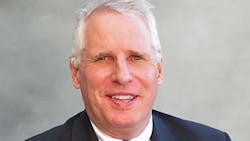If you have opened up your 401K statement lately or spent too much time listening to the Presidential candidates ranting about our current state of affairs in America, you might be inclined to start checking Zillow.com for a nice, quiet hut on some obscure South Sea island.
But when you take the time to ignore all the verbal clutter from candidates of all political persuasions for a few minutes, take the long-term view on your retirement account, and consider some key economic measures that monitor the true health of the economy, you will find that things aren’t quite as bad as they may currently seem.
At the recent annual conference of the National Association of Wholesaler-Distributors (NAW), Washington, D.C., Alan Beaulieu, president of ITR Economics, Manchester, N.H., offered a very understandable economic perspective on the state of the U.S. economy. He believes that outside of the ghastly decline in the energy patch, the U.S. economy is actually in pretty good shape and is showing plenty of signs that it will improve by mid-year. He says that while the current lull in the economy’s rate of growth is scary, it’s temporary.
Beaulieu points to the solid gains in employment, housing starts, nonresidential construction and retail sales as four particularly bullish economic indicators and said in his presentation that closer NAW members are to consumer goods they better they will feel. While he agreed that the pain felt by anyone in the oil market is real, he believes that over the course of the year oil prices should start improving and that they may be over $40 a barrel by the end of 2016.
Some of Electrical Wholesaling’s pet economic indicators that do the best job of measuring the health of the electrical market also point to an industry that’s doing a heckuva lot better than most of the Presidential candidates from both sides of the aisle would lead you to believe. Nationally, employment at electrical contractors — which can easily account for 40% to 50% of the average electrical distributor’s business — is sitting comfortably above 800,000, a level typically only seen in the best of economic times, and through Nov. 2015 was growing at a solid 5% rate year-over-year through November.
The Architecture Billings Index (ABI), a leading economic indicator of construction activity published monthly by the American Institute of Architects (AIA), Washington, D.C., ended 2015 in positive terrain and was up in eight of the twelve months of the year. And AIA’s new projects inquiry index was up 60.2 points in December, well over the 50-point mark indicating a growth market for AIA members. Another AIA economic indicator, its Consensus Construction Forecast, factors in the forecasts of the seven different economists that focus on the construction market and is calling for 8.2% growth in 2016 nonresidential construction.
That’s quite a bit higher than the 3.8% electrical industry growth that we forecast in Electrical Wholesaling’s 2016 Market Planning Guide or the lower growth rate Herm Isenstein is calling for in his DISC Report, but it’s clear that good things are happening in many key markets. All business is local, and industrially oriented distributors in Texas, along the Gulf Coast or in the Bakken region of North Dakota may not see anywhere near this type of growth for some time, but it does exist for companies in other regions of the country.
As we enter the state primary phase of the U.S. Presidential election campaign, the next time you hear politicians ranting about the decline of civilization, turn down the volume if you want to get a better read on the real state of affairs.
Instead, pick up the phone and call a few customers and ask them how their business is doing, and how 2016 is really is shaping up. And as long you have your 401K or IRA in a diverse mix of funds, shred those monthly retirement account statements when they come in — at least until mid-year, when things should start picking up again.
About the Author
Jim Lucy
Editor-in-Chief of Electrical Wholesaling and Electrical Marketing
Jim Lucy has been wandering through the electrical market for more than 40 years, most of the time as an editor for Electrical Wholesaling and Electrical Marketing newsletter, and as a contributing writer for EC&M magazine During that time he and the editorial team for the publications have won numerous national awards for their coverage of the electrical business. He showed an early interest in electricity, when as a youth he had an idea for a hot dog cooker. Unfortunately, the first crude prototype malfunctioned and the arc nearly blew him out of his parents' basement.
Before becoming an editor for Electrical Wholesaling and Electrical Marketing, he earned a BA degree in journalism and a MA in communications from Glassboro State College, Glassboro, NJ., which is formerly best known as the site of the 1967 summit meeting between President Lyndon Johnson and Russian Premier Aleksei Nikolayevich Kosygin, and now best known as the New Jersey state college that changed its name in 1992 to Rowan University because of a generous $100 million donation by N.J. zillionaire industrialist Henry Rowan. Jim is a Brooklyn-born Jersey Guy happily transplanted with his wife and three sons in the fertile plains of Kansas for the past 30 years.
